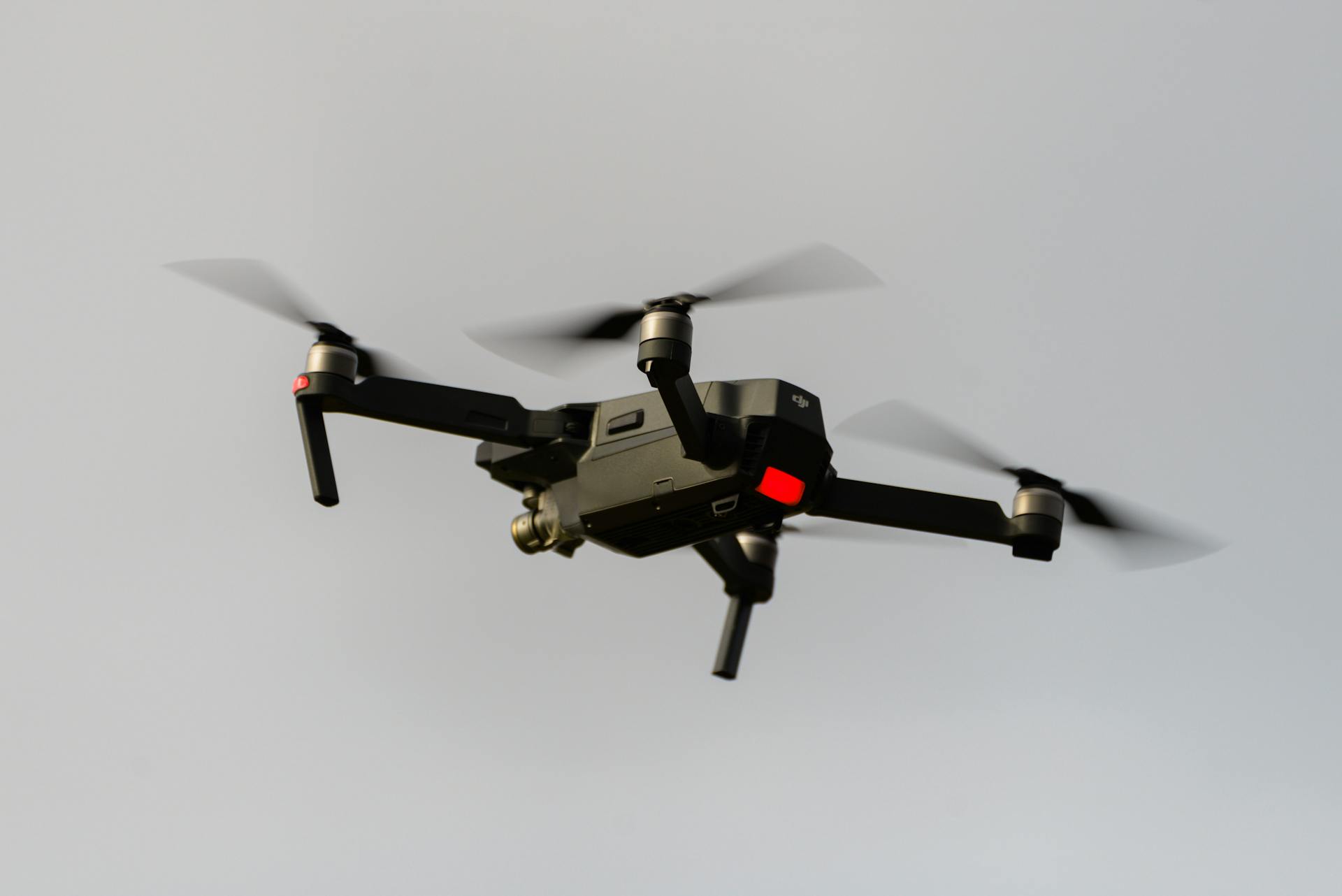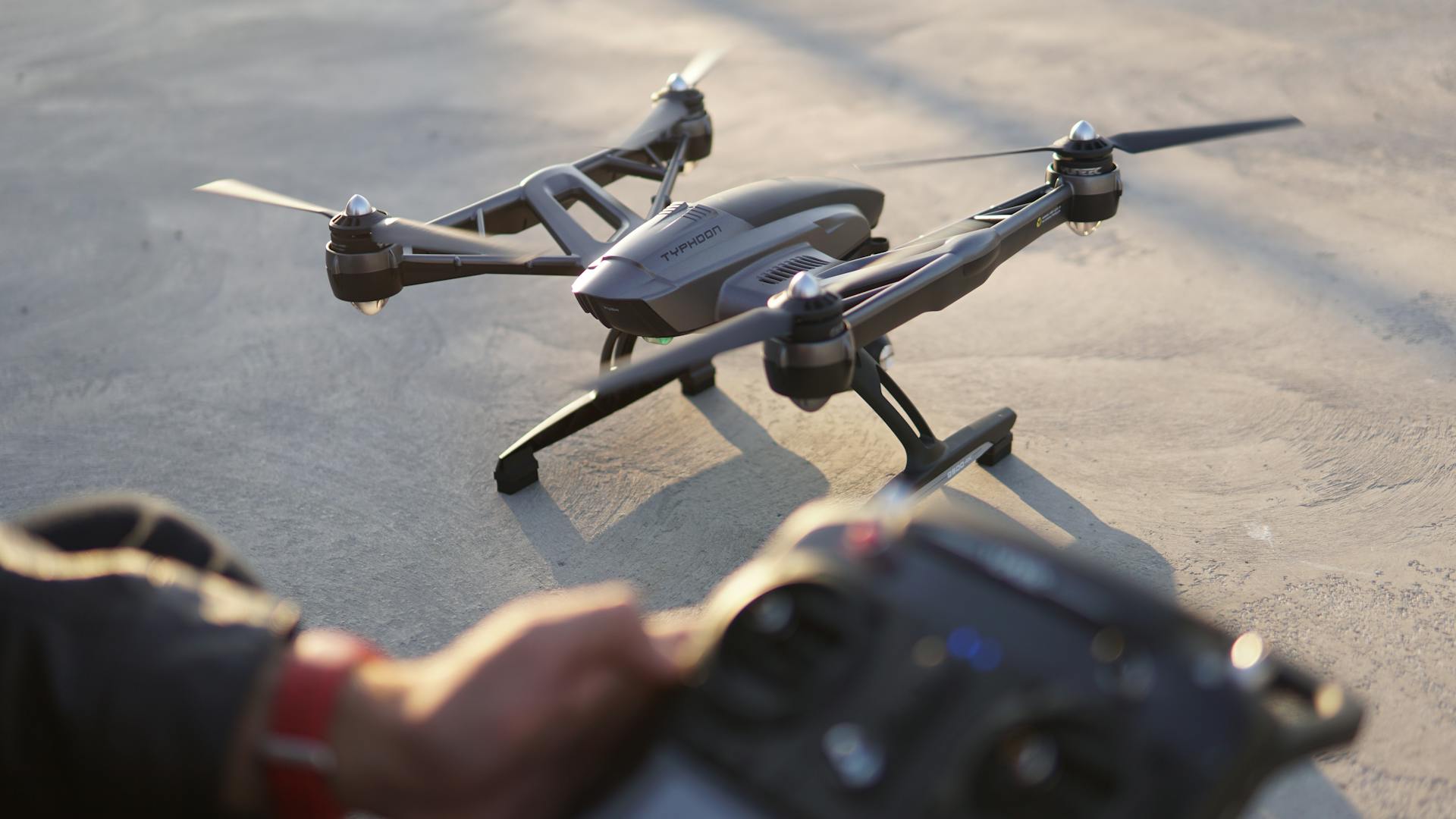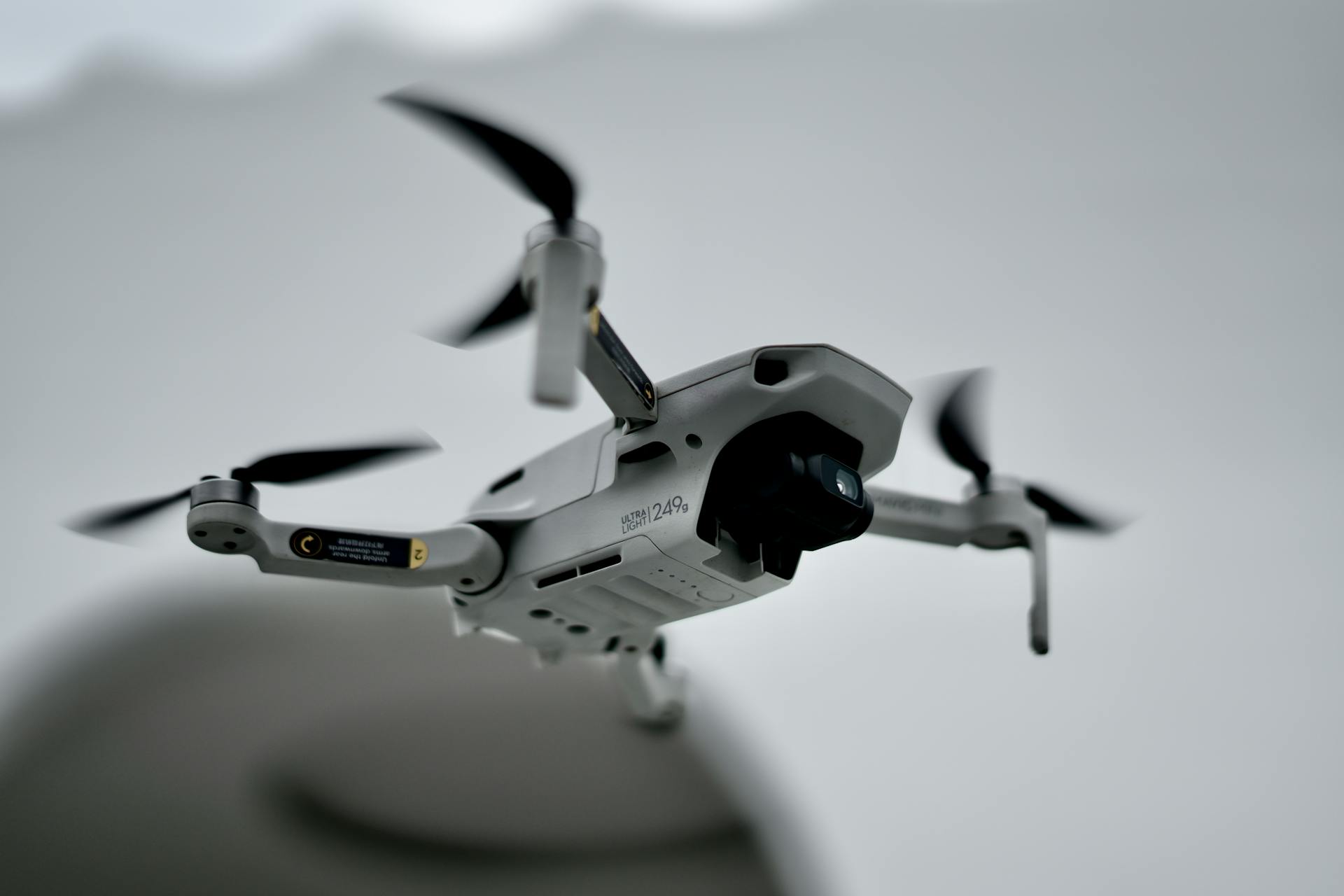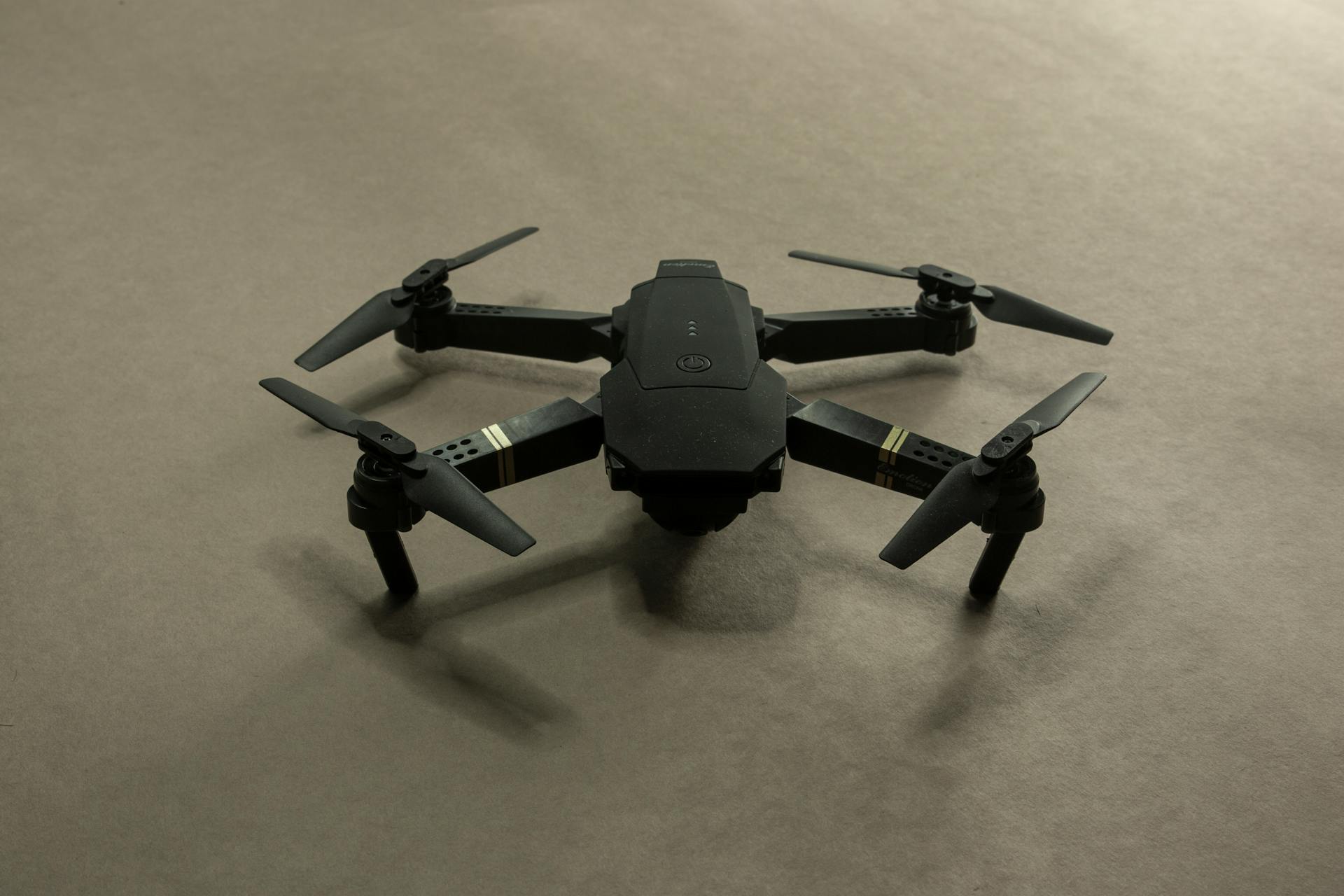
Choosing the right quad helicopter drone can be overwhelming with all the options available. There are many factors to consider, including the type of camera, flight time, and price.
A good starting point is to determine your budget, which will help narrow down your options. For example, a drone with a high-quality camera may cost upwards of $1,000, while a more basic model can be found for under $200.
Consider the type of flying you'll be doing most often, such as indoor or outdoor, and choose a drone that's designed for that purpose. Some drones are specifically designed for indoor use and have features like obstacle detection and GPS.
Flight time is another important factor to consider, especially if you plan on flying for extended periods. Some drones can fly for up to 30 minutes on a single charge, while others may only last for 5-10 minutes.
Suggestion: Military Drone with Camera
How it Flies
The quadcopter's flight is a remarkable process that's made possible by its four motors and clever control systems. The movement on the remote control sticks sends signals to the central flight controller.
Here's an interesting read: How to Make a Remote Control for a Drone
This central flight controller is the brain of the operation, directing the Electronic Speed Controllers (ESCs) of each motor to increase or decrease speed. The ESCs receive the signals and send them to the motors, which then adjust their speed accordingly.
The quadcopter's movement is a result of the combination of thrust from the four motors, which are arranged in a way that allows for pitch, yaw, and roll. To adjust its altitude, the quadcopter applies equal thrust to all four rotors.
To adjust its Yaw, or make it turn left or right, the quadcopter applies more thrust to one set of motors. For example, it may apply more thrust to the two motors that spin clockwise to make a turn.
The quadcopter's ability to adjust its pitch and roll is made possible by applying more thrust on one rotor and less to the other opposing rotor. This is achieved by the central flight controller sending the necessary signals to the ESCs.
Angular momentum plays a crucial role in the quadcopter's flight, as it depends on how fast the rotors spin. The moment of inertia is similar to mass, but deals with rotation, and is calculated by multiplying the angular velocity by the moment of inertia.
Here's a breakdown of the key components involved in the quadcopter's flight:
- Remote Control Stick Movement
- Central Flight Controller
- Electronic Speed Control Circuits (ESCs)
- Motors and Propellers
- Quadcopter Movement or Hover
Motors
Motors are the heart of your quadcopter drone, and selecting the right ones is crucial for a smooth and stable flight. A typical quadcopter uses four motors, each with its own unique specifications.
Most quadcopters use brushless DC motors, which consist of a rotor with a permanent magnet and a number of electromagnets surrounding it. These motors can have anywhere from 2 to 14 poles, with a higher number of poles allowing for more precise control.
The KV rating of a motor is a critical specification, as it determines the number of revolutions per minute (RPM) the motor will turn when a 1-volt potential difference is applied. Typical KV ratings for quadcopters range from 500 to 2500, with a low KV motor suitable for larger propellers and a high KV motor for smaller propellers.
Here's a rough guide to motor KV ratings based on quadcopter weight:
The maximum current rating of the motor is also essential, as it determines the required power distribution board and battery. It's always a good idea to choose an ESC that's rated higher than the motor's maximum current.
Brushless Motors
Brushless Motors are the standard choice for quadcopters, and for good reason. They're more efficient, reliable, and quieter than brushed motors.
Brushless motors consist of a rotor with a permanent magnet and a number of electromagnets surrounding it, also called poles. The greater the number of poles, the more precisely the motor can be controlled.
Most quadcopters use 2 to 14 poles, with more poles allowing for more precise control. The number of poles also affects the motor's KV rating.
The KV rating is a measure of the motor's revolutions per minute (RPM) when a 1-volt potential difference is applied. Typical KV ratings for quadcopters are between 500 and 2500. A low KV motor can swing a big propeller and create a larger amount of thrust.
Here's a rough guide to KV ratings based on quadcopter weight:
It's essential to choose a motor with the correct KV rating for your quadcopter's weight.
Motor Brands

The world of motors is dominated by a few key players, with some brands standing out for their reliability and performance.
Honda is known for its fuel-efficient engines, with some models achieving up to 40 miles per gallon in the city.
Toyota is another popular brand, famous for its durable and long-lasting engines, with some models lasting well over 200,000 miles without major repairs.
Volkswagen is a German automaker that produces a wide range of motors, from small city cars to powerful sports cars.
Hyundai is a South Korean brand that has gained popularity in recent years for its affordable prices and feature-packed models.
Ford is an American icon, producing a variety of motors, from compact cars to rugged trucks.
Motor Direction
Motor direction is crucial for a quadcopter's flight control, particularly in the vertical plane.
The direction of the propeller blades determines the force of gravity against the quadcopter, with the spinning blades pushing air down and creating an upward force.
A quadcopter can hover, climb, or descend in the vertical plane by controlling the thrust of its four rotors.
To hover, the net thrust of the four rotors must be exactly equal to the gravitational force pulling it down.
By increasing the thrust of the four quadcopter rotors, the upward force can be greater than the weight and pull of gravity, causing the quadcopter to climb.
To rotate the drone, a decrease in the angular velocity of motor 1 is required, but this can also decrease the thrust from motor 1, causing the quadcopter to descend.
To rotate the drone without creating imbalances, a decrease in the spin of motors 1 and 3 with an increase in the spin for rotors 2 and 4 is needed.
The direction of the propellers also affects the drone's pitch and roll, with an increase in the motor rpm of rotors 3 and 4 and a decrease in the rate of rotors 1 and 2 required to fly forward.
By increasing the rotation of the rear rotors, a greater force is produced, causing the drone to tilt forward.
Explore further: Ar Drone 1
Flight Mechanics
A quadcopter's flight is made possible by its ability to create a force that equals or exceeds the force of gravity. This is achieved through the spinning of its propellers, which push air down and create an upward force.
The central flight controller is the brain of the quadcopter, taking information from various sensors and making calculations to control the flight and stability of the drone.
To hover, the net thrust of the four rotors must be exactly equal to the gravitational force pulling the drone down. This is achieved by balancing the thrust of each rotor.
To climb, the thrust of the four rotors must be increased so that the upward force is greater than the weight and pull of gravity.
Flying forward, backward, or sideways is achieved by adjusting the rotation rate of the rotors. For example, to fly forward, the rear motors must spin faster than the front motors.
If this caught your attention, see: Drone Taking down Helicopter in Ukraine
Here are the three main movements of a quadcopter: Yaw (rotating or swiveling of the head), Pitch (movement forward and backward), and Roll (movement sideways).
A quadcopter can do three things in the vertical plane: hover, climb, or descend. The direction of the propellers is crucial in controlling the force of gravity against the quadcopter.
Here are three online quadcopter motor thrust calculators:
- eCalc Multicopter Thrust Calculater
- DriveCalc Quadcopter Lift Calculator
- GoBrushless Thrust Calculator
Design
The JetQuad's design is a game-changer in the world of quad helicopter drones. It's the size of a large suitcase, making it incredibly compact and portable.
The AB6 JetQuad produces a maximum of 840N from four micro jet-engines, giving it a significant boost in power and speed. It's ready to fly out-of-the-box using a shoulder-mounted ground-station and requires no assembly to launch, which is a huge advantage over other drones.
The JetQuad's unique design allows it to operate in environments normally inaccessible by propeller-based drones, making it a versatile and reliable option.
Design
The AB6 JetQuad is a compact jet-engine drone, the size of a large suitcase, and produces a maximum of 840N from four micro jet-engines.
Its innovative design makes it ready to fly out-of-the-box using a shoulder-mounted ground-station and requires no assembly to launch. This is a game-changer for drone enthusiasts who want to fly without the hassle of assembly.
The JetQuad has no external airfoils and will operate in environments normally inaccessible by propeller-based drones, making it a versatile option for various applications.
The frame of a quadcopter is what holds it together, and it can be made of materials like wood, plastic, or carbon fiber. Carbon fiber is strong but can be brittle, so it's essential to consider this when choosing a frame.
A common frame size for quadcopters is 180, 250, or 400 millimeters, with racing quadcopters often using the 250 millimeter variety. This size affects the drone's stability and maneuverability.
Some hobbyists build their own frames, often out of wood, which is a good choice due to its ease of workability and affordability. Wood can be modified to attach accessories, but it can also warp, causing the drone to fly erratically.
Broaden your view: Quadcopters
Large or Smaller
In quadcopter design, choosing between large or smaller propellers is a crucial decision. Typically, multi-rotors use props with pitches in the range of 3 to 5 inches.
Larger propellers require more energy to spin and increase power consumption. A prop with a smaller diameter or pitch can spin faster, pulling less current from the motor.
Higher pitch propellers generate more thrust, but also use more power. This can make them less efficient, especially for longer flight times.
Smaller propellers, on the other hand, tend to run smoother and feel more responsive to the sticks. They also help stability by providing a faster change of RPM due to less inertia.
External Shell Swap
The JetQuad's external shell swap feature is a game-changer. It allows users to swap out different shells to create a wide range of aircraft designs.
One of the examples of external shells is the Blended Wing Body (BWB) design. This design has the potential to be more efficient than traditional aircraft designs.
You can even design a shell that looks like a "Flying DeLorean" if you want to get creative. The possibilities are endless with the JetQuad's external shell swap feature.
The JetQuad can accommodate a vast variety of external shells, so you're only limited by your imagination.
Components
The brains of your quadcopter is the Flight Controller, which controls the speed of your motors by sending signals to your ESCs.
Simple flight controllers contain only gyros, which are quite sufficient for most beginners, but advanced flight controllers have more features and are coupled with sensors like gyros, accelerometers, sonar, GPS, and magnetometers.
A Flight Controller is actually a small computer that can be programmed and updated by connecting it to your computer, and despite its complexity, it's actually not that expensive.
The central flight controller takes information from various sensors, including IMU, Gyroscope, GPS modules, and obstacle detection sensors, and uses programmed flight parameters and algorithms to send data to the electronic speed controllers.
Most flight controllers encompass the IMU, GPS, Gyroscope, and other features to control the quadcopter's flight and stability, and some even have dual IMUs for redundancy and safety features like Return-To-Home.
See what others are reading: Military Drone Controller
Prop Size Explained
Prop size is crucial for a quadcopter's performance, and it's not just about choosing any propeller that fits. Generally, cheaper props are less precisely manufactured and more prone to creating vibration.
The size of a propeller is measured by its length, pitch, and bore. The length, or diameter, is the distance across the propeller's widest point, usually given in inches. A larger propeller can lift more weight but uses more current.
Prop pitch is another important measurement, defined as the distance a propeller would move forward through a solid in a single full revolution. A higher pitch propeller can move more air, but it's also more prone to vibration.
The bore measurement is simply the size of the hole in the center of the propeller, which must match the shaft of your chosen motors. Adapters are available to downsize a prop's bore if needed.
Self-locking props are now the norm, with propeller threads that are the opposite of motor spin direction, keeping them securely in place during flight.
Electronic Speed Control
Electronic Speed Control is an essential component of modern quadcopters. It's an electronic circuit that varies the speed of the motor, its direction, and even braking.
For more insights, see: Military Drone Speed
Each quadcopter motor has its own Electronic Speed Control (ESC) circuit. These ESCs are really small and compact.
Electronic Speed Controllers offer high power, high frequency, and high resolution 3-phase AC power to the motors. This is crucial for quadcopters and drones, which depend entirely on the variable speed of the motors driving the propellers.
Quadcopters and drones rely on the wide variation in RPM thrust and control in motor/propeller speed to fly. This is what gives the quadcopter all the necessary control to fly.
To understand more about Electronic Speed Controllers, you can check out the video "RC Basics – The ESC".
A fresh viewpoint: Quadcopters Drones
Noise Suppression
Noise Suppression is a crucial aspect of the JetQuad's design, and FusionFlight is developing innovative technologies to minimize its impact. The company is working on both passive and active noise suppression systems.
The frequency of the noise plays a key role in its suppression. The JetQuad engines operate at an incredibly high RPM of over 100,000rpm, compared to 10,000rpm of comparable quadcopters and helicopters.
Higher frequency noise travels shorter distances through air, making it less of a concern for those nearby. This is a significant advantage, as it means the noise dies down quickly as you move away from the JetQuad.
Even though the jet-engines are loud up-close, reaching levels of 100dB, the noise is still effectively suppressed as you move further away.
Dual-Battery with 35-Min Flight Time
The Commander quadcopter drone features dual redundant smart batteries, which provide a reliable power source for extended flight times.
This dual-battery setup allows for a maximum flight time of 35 minutes, making it ideal for large projects that require a lot of coverage.
With this kind of endurance, you can complete complex missions without worrying about running out of power.
Radio and Control
Your quadcopter's radio system is made up of a receiver and a transmitter. The receiver is on-board the quadcopter, while the transmitter is the handheld device you'll use to control it.
The number of channels on your radio system determines how many functions or devices you can control. At minimum, you'll need four channels to control a quadcopter, but most people start with at least six.
A single channel can control a specific function, such as throttle, yaw, pitch, or roll. These four basic channels cover the essential movements of your quadcopter.
You can buy a transmitter and several compatible receivers if you plan to fly multiple quadcopters. This is a good strategy, as it allows you to afford a high-quality transmitter, while receivers are generally inexpensive.
For your interest: Remote Control Military Drone
Flight Controllers
Flight controllers are the brains of your quadcopter, controlling the speed of your motors by sending signals to your ESCs.
Advanced flight controllers have more features and are coupled with sensors such as gyros, accelerometers, sonar, GPS, and magnetometers. Simple flight controllers contain only gyros and are quite sufficient for most beginners.
Flight controllers are small computers that can be programmed and updated by connecting them to your computer.
They accept signals from the onboard radio receiver to control your quadcopter remotely. The flight controller then does its magic and sends signals to the ESCs to control the motor speeds.
Despite their complexity, flight controllers are not that expensive, making them a worthwhile investment for any quadcopter enthusiast.
Radio Equipment
Radio equipment is a crucial part of flying a quadcopter, and it's essential to understand the basics.
You'll need a radio transmitter and receiver to control your quadcopter, and the quality of these components can make a big difference in your flying experience.
Each channel in the radio system controls a single function or device, with a minimum of four channels needed to control a quadcopter: throttle, yaw, pitch, and roll.
Most people start with at least six channels, which can also be used to control lighting or a gimbal motor to position a camera.
The mode 1 configuration has the elevator control on the left joystick and the throttle control on the right joystick, but mode 2, which reverses these controls, is the most popular configuration.
If you're a beginner, it's generally advised to set your equipment up to work in mode 2.
Buying a good quality transmitter and several compatible receivers can be a cost-effective strategy if you plan to use several quadcopters.
Applications
The JetQuad drone is a game-changer for areas with limited infrastructure or no access to the electrical grid. It's perfect for ultra-fast and heavy delivery by air.
Speed is key when it comes to saving lives, and the JetQuad drone delivers. It can transport life-giving payloads like organs and medications in a timely manner.
In areas where traditional trucks and helicopters get stuck, the JetQuad can provide logistical support. Its lack of external air-foils makes it resilient in adverse weather conditions.
The JetQuad is also a cost-effective alternative for long-range surveillance, making it ideal for oil and gas companies to survey pipelines for damage.
Applications Examples
The JetQuad drone is a game-changer in areas with limited infrastructure or no access to the electrical grid. It can deliver heavy payloads quickly and efficiently.
In emergency situations, speed is crucial for patient survival, and the JetQuad drone is perfectly suited for this task, capable of delivering life-giving payloads in a timely manner.

Its ability to operate in adverse weather conditions makes it a reliable choice for areas with harsh climates. The lack of external air-foils makes it resilient in windy conditions.
For oil and gas companies, a JetQuad can be a cost-effective alternative to manned airplanes and helicopters for long-range surveillance, performing the same missions for less cost.
Navy SEAL Saves Lives in Combat
A Navy SEAL's training and expertise can make all the difference in combat situations. They are trained to perform under extreme pressure and make quick decisions that can save lives.
In a high-stress environment, a SEAL's ability to remain calm and focused is crucial. This is why they undergo rigorous training to develop their mental toughness.
A SEAL's physical fitness is also a key factor in combat. They must be able to sustain themselves over long periods of time, often in extreme conditions.
Frequently Asked Questions
What is a drone with 4 propellers called?
A drone with 4 propellers is called a quadcopter. This design allows for stable and controlled flight.
Are quadcopters safer than helicopters?
Quadcopters are generally safer than helicopters due to their mechanical simplicity and reduced kinetic energy. This makes them less likely to cause damage, but it's essential to consider other factors for overall safety.
How high can quad drones fly?
Typically, quad drones are limited to flying 400 feet above ground level to ensure safe airspace and avoid conflicts with manned aircraft
Sources
- https://dronebotworkshop.com/how-does-a-quadcopter-work/
- https://draganfly.com/products/quadcopters-multirotors/
- https://www.dronezon.com/learn-about-drones-quadcopters/how-a-quadcopter-works-with-propellers-and-motors-direction-design-explained/
- https://fusionflight.com/jetquad/
- https://www.wired.com/story/shield-ai-quadcopter-military-drone/
Featured Images: pexels.com


